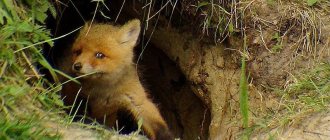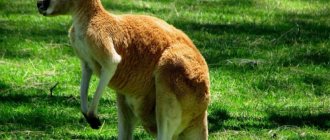- Wild animals
- >>
- Mammals
The common fox is one of the most popular fairy tale characters, closely associated with Slavic mythology. Many people associate this animal with deceit and cunning. It is familiar to every person since early childhood. But not everyone can boast of real knowledge about the natural habits and natural characteristics of such an animal as the common fox. And this is a rather interesting, unusual predator!
Origin of the species and description
Photo: Common fox
The common fox is a predatory mammal. It belongs to the canine family. The name comes from the Old Slavonic adjective “fox”. It meant a red, yellowish color. It is this that is most characteristic of this animal. The canine family is quite large. There are more than fifty subspecies of foxes alone. This figure does not include the smallest forms of this predator.
The common fox is the largest representative of its genus. The weight of such a predator can reach ten kilograms. The length of the animal including the tail usually does not exceed one hundred and fifty centimeters. The fox is famous for its bushy, long tail. It not only decorates it, but also performs a useful function - it serves as a kind of stabilizer while running. In the winter season, the tail protects foxes from the cold while sleeping.
Fun fact: Foxes share many traits with domestic cats. The peak activity of these animals occurs at night; they have excellent vision, similar hunting tactics, a rough tongue and protruding claws.
Common foxes are a valuable species of predator. They are of high economic importance. Such animals act as fur suppliers and are natural regulators of the number of rodents and small and medium-sized insects. However, it is foxes that bring great harm to humans. They can prey on poultry and are the main carrier of rabies, a dangerous and incurable disease.
False fox species
Arctic fox
It is called the Arctic or polar fox, and is even sometimes included in the generic group of foxes. But this is still a separate species of the Arctic fox genus. Body size and weight are close to those of a regular fox, only slightly smaller. But the physique, compared to the red-haired rogue, is stockier. Colors include white and blue.
Both of these varieties have different coat shades at different times of the year. The white animal turns grayish in summer and looks dirty. The winter skin of the blue animal is usually charcoal gray with a blue tint, sometimes even coffee-colored with silver. In summer, the color becomes reddish-gray or dirty brown.
It lives on the northern shores of our continent, America and the British possessions, as well as on the islands of cold seas beyond the Arctic Circle. Selects tundra open spaces. It feeds on everything, like foxes, the main food is rodents, although it can attack a reindeer. Doesn't disdain fish carcasses on the shore.
Loves both cloudberries and seaweed. They can often be seen in the company of polar bears, picking up leftover food from the giants. Burrows are dug in the loose soil of sandy hills. They live in families and create one couple forever. Life expectancy is 6-10 years. A valuable game animal, especially the blue fox.
Maikong
Savannah fox, one of a kind. It can sometimes be mistaken for a small jackal measuring up to 70 cm in length and weighing up to 8 kg. Fluffy gray fur with a silvery touch, sometimes tinged with reddish, a bushy tail, an almost black stripe running along the back and along the tail. There are areas of fawn color visible on the sides.
It lives in wooded and grassy plains, occupying the eastern and northern coasts and the central part of the South American continent. Like other foxes, it eats almost everything. But this animal’s diet includes marine invertebrates and crustaceans. Hence the name “crabeater fox”.
Enjoys eating vegetables, fruits and berries. They don’t dig holes themselves; they often occupy other people’s holes. They can share territory with another relative. Offspring in the amount of 2-4 puppies are produced twice a year, the peak birth rate falls in the first months of the year. How long they live in nature has not been established; in captivity they can live up to 11 years.
Appearance and features
Photo: Common fox predatory animal
The fox is famous for its attractive, very interesting appearance, soft and beautiful fur. This is a fairly large predator, whose weight can reach ten kilograms and body length - ninety centimeters. The animal's tail has a length of forty to sixty centimeters. Its length will depend on the subspecies of the animal.
Common foxes have a strong jaw. In total, the animal has forty-two teeth, which can easily cope with almost any food. The predator's ears are characteristic: triangular in shape, slightly elongated, rather large. There is a sharp tip at the tip of the ears.
Video: Common fox
The animal's vision is excellent. They navigate the area well even in the dead of night. But, oddly enough, when moving and hunting, foxes are accustomed to relying not on vision, but on other senses: smell, touch. They have excellent hearing and a very sensitive nose.
The coat color of representatives of this genus may differ from each other. Foxes are red, yellowish, black-brown. Their fur is quite thick and dense. It is highly valued among people not only for its performance qualities, but also for its appearance. This fur looks impressive.
Interesting fact: All subspecies of the common fox, regardless of size and region of residence, have common features in appearance. All animals have dark ears and a white tail.
The summer fur of foxes is very short and sparse. Winter is more appreciated by people. It is thick and lush. Molting for these predators occurs from February to July. After this, the growth period of winter fur begins. By November, the chanterelles are fully dressed in winter wool.
Fox photo
About the fox.
The fox is one of the most popular heroines of fables, fairy tales and proverbs. Since childhood, each of us knows that this red-haired trickster is cunning and curious, and also beautiful, thanks to her valuable fluffy fur coat.
The fox is a small animal. On average, the body length of an adult reaches 60–80 centimeters, half of which is the fluffy tail. The weight is 6 – 10 kilograms.
These red animals inhabit almost all continents with the exception of Antarctica. You can see a fox both in dark, untouched forests and near villages and hamlets. Moreover, the second option for life is much more attractive to her.
Burrows of cheats can be found almost next to the houses of the villages. This is explained by the fact that the fox is practically not afraid of humans, and it is even beneficial for it to live close to humans.
This cunning animal benefits agriculture by feeding on rodents. Daily norm for her diet: about 20 mice or hamsters. At the same time, the fox often raids chicken coops: poultry meat is its favorite delicacy.
This red predator feeds not only on the meat of rodents and poultry, but also on fish, insects, earthworms, and also some vegetables. She also wouldn’t refuse hare meat, but catching such a fast animal is quite a difficult task for a fox, so the established opinion that the hare comes first in the diet of this red cheat is wrong.
“A fox will lead seven wolves,” as the Russian proverb says about its outstanding trait - cunning. Indeed, the fox often confuses its tracks, leading the hunter into a dead end, and also uses other tricks.
The cheat is also a wonderful actress. There are times when a red-haired predator passes by partridges, not paying any attention to them, and can even lie down nearby and seem to fall asleep. This behavior confuses the birds. After a while, they stop worrying and continue going about their business. At this moment it is time to attack. The fox quickly grabs the gaping partridge and goes to eat.
The red-haired cheat is distinguished by her curiosity. Often this feeling leads her to problems. A fox can come into a person's yard, which is guarded by a dog, or come close to a trap, studying an unknown object. If not for its acute sense of smell and excellent hearing and vision, this animal would hardly have been able to avoid most of the problems in its life.
Developed hearing helps the fox to hunt. If a mouse squeaks within a radius of 100 meters somewhere under the snow, the predator will immediately determine its location. Slowly creeping up, she will wait for the rodent to make some rustling noise, after which she “dives” her whole body into the snow with lightning speed, leaving only her fluffy red tail on the surface. Within a moment you can see the cheat feasting on fresh prey.
The mating season for these representatives of the canine family occurs at the end of January - beginning of February. During this period, most often the female is courted by several males, between whom frequent fights arise for the bride. Only the strongest have such an honor - to continue the race with a female.
Males are wonderful family men! They are very caring towards the female: they bring her food and build burrows. Often the couple starts games, as well as “dancing”.
The offspring appears after a 50-day pregnancy. Parents care for the cubs: they feed them, teach them how to hunt, and protect them from strangers. Even if a person accidentally comes across a fox hole and passes by without touching it, the cubs will be transferred by their parents to another safe place that same night.
There is only one bad thing: the wild fox is a carrier and distributor of rabies, so it remains obvious that it is necessary to monitor the number of this animal.
The fox can be tamed and kept as a pet.
See more photos of foxes in winter.
Where does the common fox live?
Photo: Animal common fox
The natural habitat of common foxes is quite wide. These animals live throughout Europe, Asia, North Africa, and North America. It was introduced and acclimatized in Australia. Now such an animal has spread throughout almost the entire continent. The exception is the territories located in the north. About fifteen subspecies of this predator live in Europe, and more than thirty in other countries.
In the above countries, foxes are found in all landscape and geographical zones. They feel great in the tundra, steppe, desert, mountains, and subtropical forests. At the same time, they easily adapt to different climatic conditions. The only exceptions may be areas with very high humidity. The population density of animals in geographical areas is completely different.
Interesting fact: Despite the high adaptability of foxes, a larger number of them were seen in the forest-steppe and steppe zones. They prefer open areas, despite the myth that such animals live exclusively in dense forest.
Most of the population of these predators lives in the wild. However, increasingly, foxes can be found near villages, towns, and cities. Single individuals have even been spotted by people in the central parts of large cities. Foxes have adapted perfectly to such conditions. They find food in parks, basements of residential buildings, city dumps, and agricultural buildings.
The genus of true foxes includes 10 species
Common fox
Of all foxes, it is considered the most common and largest in size. The body length reaches 90 cm, weight – up to 10 kg. It lives throughout almost the entire territory of Eurasia, except for the very south of Asia - India and part of China. It is easy to find in North America (from polar regions to tropical regions), and even in the north of the African continent - in Egypt, Algeria, Morocco and northern Tunisia.
The most common colors are a fiery red back, a snow-white belly, and brown paws. The further north the region of residence, the more interesting and richer the rogue’s fur, and the larger it itself is.
The famous black and brown fox is found closer to the north. Southern specimens are smaller and duller in color. Dark ears and the white tip of a bushy tail are the icing on the cake that all these foxes share.
The muzzle is elongated, the body is slender, the legs are thin and low. Sheds from early spring to mid-summer. Following the fall, new fur grows, even more beautiful than the previous one. Foxes' ears are an important device; with their help, they detect subtle sounds and easily find prey.
Hunting for small rodents occurs alone, and predators hear them through a layer of snow, track them down and dig out the snow cover with their paws. This kind of hunting is called mouseing, and the fox was very successful at it. It can also catch a larger animal - a hare or a baby roe deer.
The fox will not miss a bird if it comes across it during the hunt. Moreover, it feeds on insects and their larvae, fish, plants and their roots, fruits and berries, and even the corpses of animals. An absolutely omnivorous animal, like all foxes. They live in large families, similar to small colonies.
The burrows are either dug themselves or inhabited by badgers and marmots left behind. These structures contain a number of exit holes and intricate passages, as well as several nesting chambers. But they live in underground dwellings only during the period of feeding their children, and then they only take refuge in them in case of danger.
And the rest of the time they prefer to be on the surface of the earth, hiding in the grass or under the snow. Offspring are produced once a year, and only a well-fed and healthy female is ready for reproduction. Sick individuals skip this year.
From 5 to 13 puppies are born, and caring parents take care of their upbringing together. In the wild, foxes live up to 7 years, in the comfort of a zoo - up to 18-25. They are often exterminated due to dangerous diseases that have arisen that can spread among other animals - rabies, plague of predators and scabies.
American corsac
Dwarf agile fox or prairie fox. The dimensions are small - the body is up to half a meter long, the tail size is another 30 cm, the weight is no more than 3 kg. The standard color is slightly grayish with coppery-yellowish areas on the sides. During the summer months the color becomes brighter. They live in the USA, east of the Rocky Mountains of the Cordillera system.
They prefer visible areas - steppes, wastelands or grass-rich pampas. They can easily move to another place, so they do not mark possessions. True, males migrate more often, females remain and protect home areas, the size of which is about 5 sq. km. The production of offspring in the southern United States begins in December, in the north - in March.
Corsacs are very cautious, their life has been little studied. At a hint of danger, they run away at speeds of up to 60 km/h. Because of this, they are called “fast foxes.” Fur is not popular due to its coarse structure and small size of the skin.
But they themselves often fall into traps set for ordinary foxes and coyotes. The number of corsacs has been rapidly declining in recent years, and they are practically non-existent in Canada, where a large population was previously observed. Therefore, in the near future they may be included in the Red Book.
Afghan fox
Another name is Balochistan or Bukhara fox. A small animal, in size and body weight close to the American corsac. The size of the tail is approximately equal to the length of the body. The color is grayish-brown with a dark coating along the back and along the tail. She can be called a fox with the appearance and manners of a cat.
The muzzle really looks like a cat's, shorter than that of other foxes. Quite large ears are set on the head, which serve not only as a locator, but also help cool the body in the heat. After all, the distribution area of this animal is in hot regions - the Middle East, southern Arabia, northern and part of central Africa.
The greatest density occurs in the territory of Afghanistan, eastern Iran and the north-west of the Hindustan Peninsula. To the north, the species is replaced by the common fox. Plants are largely added to the wide range of menus, firstly, because of the moisture they contain, and secondly, in hot climates they better promote digestion.
African fox
In terms of physique, it is a smaller copy of an ordinary fox. The color is more “dusty”, sandy shades, masquerading as the surrounding nature. Little has been studied so far, but it has been established that they also live in families and dig huge burrows up to 15 meters in length and up to 3 meters in depth. Distributed in central Africa, south of the Sahara.
They occupy a wide strip from the Atlantic coast to the Indian Ocean coast. They live in desert sands or among rocky plains, and can sometimes settle next to people. They are often exterminated for raiding poultry houses. Apparently, poor food conditions force them to look for food from people. In captivity they do not live long - up to 3 years; in freedom they can live up to 6 years.
Bengal fox
This beauty has a small graceful body - with a weight of 3.5 kg, it reaches 55-60 cm in length, the size of the tail with a dark tip is up to 35 cm. Her legs are longer in relation to her body than those of many other foxes. Color varies from sandy red to terracotta. Lives only in Hindustan, near the Himalayan mountains, occupies Nepal, Bangladesh and India to the very south.
It stays in open forests and can climb mountains up to 1400 m. Avoids forests and hot deserts. The diet is tailored to the local fauna - arthropods, reptiles, birds and eggs. Loves to eat fruit. In fauna it lives up to 10 years. It is a desirable object of hunting for its fluffy fur; in addition, the teeth, claws and meat of the predator are used in oriental medicine.
Korsak
The external resemblance to an ordinary fox differs only in light fur, the black end of the tail and a narrower muzzle. It lives in southeastern Europe and Asia. In places it overlaps with the Afghan fox, differing from it in its light chin and shorter tail length.
It prefers flat grassy areas with small hills, prefers steppes and semi-deserts, dry in summer and little snow in winter. The area of a family's plot can be up to 50 sq. km; it usually generously marks the territory, lays out ornate paths and makes holes in networks. They live in families, like foxes, and are also monogamous.
Having matured, the offspring scatter in different directions. But as soon as it gets colder, the family gets together. In winter, they migrate to more fertile places and are not afraid to run into populated areas. Their enemies in nature and competitors in the food supply are the common fox and wolf. It is of interest for fur hunting, as it has a rich skin. In nature, it lives up to 6-8 years.
sand fox
The size is small, the body structure is graceful, the fluffy tail is so long that this fox is often forced to drag it along the ground. The color is typical for the places where they live - sandy tones with a brown stripe along the tail and an almost white belly. Area of residence: Sahara, north and part of central Africa, the Arabian Peninsula and the Middle East.
Desert rocky and sandy spaces are her native element. The owner of rather large ears, has thick fur pads on his paws that protect from the hot sand. However, this is characteristic of all foxes inhabiting hot countries.
Like many desert inhabitants, she is capable of not drinking water for a long time, obtaining the necessary moisture from food. They have a special urinary system that does not allow frequent bowel movements. In some regions it is replaced by the brown fox, inferior to it in size. In Israel it is considered a protected species.
Tibetan fox
If you come across photos of fox species , you will immediately pay attention to the Tibetan predator. Its muzzle appears square due to the thick collar around its neck. In addition, fangs protrude from the mouth; they are larger than those of other foxes. The fur is lush, thick, with dense undercoat. The look is more wolf-like, with a characteristic squint.
The body is up to 70 cm long, the fluffy tail reaches half a meter. Weight about 5.5 kg. This predator sticks to the Tibetan plateau, choosing desert places. North-west India and part of China are its habitat. It can be seen in the mountains up to 5500m. It lives where its favorite food, pikas, is found.
Therefore, it has practically disappeared from some areas of China where pika poisoning campaigns are carried out. Supplements his diet with everything that attracts attention. The fur of these foxes is used to make hats, although it is not particularly valuable. The main threat to them is the dogs of local residents. In fauna they live for about 5 years, in zoos - 8-10 years.
fennec
A baby with large ears, living in the deserted north of the African continent. The fennec is smaller in size than some domestic cats. The body is barely 40 cm long, the tail is 30 cm long, and the miniature predator weighs about 1.5 kg. With such small dimensions, its auricles reach a height of 15 cm, therefore they are recognized as the largest among predators in comparison with the head.
The fur is dense and soft, the hair is long, the foot is pubescent to protect it from the hot sand. They live in hot sands, staying close to sparse thickets of bushes. They are very talkative and constantly talk to each other. Like all foxes, they may bark, whine, howl or grumble when communicating. Each sound expresses its own emotion.
They live in flocks of up to 10-15 individuals. They are very agile and agile, they can jump up to 70 cm high. They do not often get eaten by large animals, since their large ears perfectly hear the approach of danger. In addition, these babies have a well-developed sense of smell and vision.
What does the common fox eat?
Photo: Red fox
Foxes are typical predators. However, their diet is wider. According to research by scientists, the diet of adults includes more than four hundred types of animal food and several dozen varieties of plant food.
However, the most common foods foxes eat are:
- Small rodents. They can be called the basis of nutrition for these animals. Foxes mainly hunt mice and voles. Scientists note that the state of the fox population in a particular region depends on the number and availability of small rodents;
- Zaitsev. They are less likely to become prey to predators. Only some subspecies hunt hares and hares with particular tenacity. And during a pestilence, a predator can even feast on the corpses of these small animals;
- Birds. These animals are not as important for the life of chanterelles as rodents. But the common fox will never miss an opportunity to catch and eat a bird for lunch. The beast attacks the birds when they are on the ground. Chicks that have fallen from nests and eggs become easy prey for predators. In conditions of hunger, foxes can attack poultry. They steal them straight from the barns;
- Insects. The common fox can snack on large beetles and their larvae. She will not disdain even dead insects;
- Plant food. It does not play a key role in the animal’s nutrition. Foxes rarely consume plant foods: fruits, fruits, berries, and various roots.
Types of foxes depending on where they live
There are several types of foxes that live in different conditions:
Note!
- Euthanasia of animals.
- Spitz. Features of the breed.
Car hammock for dogs. What it is?
Steppe foxes. This species prefers to live in the steppes of Asia. For houses they use abandoned holes left by other animals. They constantly migrate from place to place, but well guard the temporary parking area. This species is smaller in size than red foxes, so when they enter the territory of their fellow foxes they often remain hungry.
Look - Wombats: description, life and habitat. 110 photos and videos reviewing the character of the marsupial representative of Australia
Mountain foxes. This type of fox typically lives in caves, hollows, and abandoned holes. The inhabitants of higher mountainous places dig their own homes. This type of animal is very secretive and little studied.
Desert foxes. Deserts and semi-deserts require special adaptation. There is little food for large predators here, so in such areas you can only find a miniature fox. They eat everything from the roots of dry bushes to lizards and small rodents.
Arctic foxes. They are inhabitants of the Far North. They are more widespread in the tundra and forest-tundra regions. There is plenty of food here and a great place for houses.
Features of character and lifestyle
Photo: Common fox
The most favorite time of day for common foxes is night. They hunt at dusk, and during the day they prefer to rest in their burrows. However, there are separate subspecies that can spend time searching for food during the day and sleeping at night. Foxes' burrows are very long and have several separate chambers. Animals break through them in the hills and slopes of ravines. The main purpose of burrows is shelter from danger and housing for future offspring.
At one time, a female can give birth to about six cubs. They live with their mother in one of the cells. For safety, females make burrows with several exits. This allows the animal and its offspring to escape in case of danger. In this way, for example, foxes escape from hunting dogs.
Interesting fact: Unlike many other mammals, foxes do not form packs. They prefer a solitary lifestyle. Adult individuals can exist together only during the breeding season. Immediately after fertilization, the female and male separate.
The fox is a very cautious, peace-loving animal. She doesn't fight unless absolutely necessary. Fights between animals occur only during the mating season and as a result of the “division” of territory. The animal tries to avoid humans, rarely when it shows itself to his eyes. Despite the caution of foxes, they are characterized by special curiosity. These animals will explore any interesting thing that comes their way.
Where is the fox's home?
It is generally accepted that the fox lives in a hole. In fact, foxes use holes only to breed offspring or to hide from impending danger, for example during a fox hunt.
To live, foxes build a den in an open place, in the grass or in the snow. The fox either digs the hole itself or can evict some animal, an arctic fox or a badger.
The hole has several entrances with underground holes for possible escape in case of danger. An old fox has several holes in different places where it takes refuge in case of impending danger.
Social structure and reproduction
Photo: Fox cub
The mating season of the common fox has the following features:
- Lasts only a few months: from January to March;
- Males can start small fights over females. However, the winner is not the strongest, but the smartest. Also during the mating season, these animals dance an unusual dance. They stand on their hind legs and walk one after another for a long time;
- At one time, a female can give birth to up to six cubs. Very rarely there are more than ten individuals in a litter. The children's ears are completely closed and there is no vision. They begin to see and hear only after the first two weeks;
- Fox cubs consume mother's milk for only a month and a half. Then they begin to get used to eating meat;
- Both parents feed the growing offspring. They have to get food almost all day long;
- A couple of months after birth, fox cubs can leave the hole on their own. Young individuals can be found quite far from their home and parents. It is then that they become victims of other, larger predators;
- The fox cubs become independent closer to autumn. At this time, they can leave their mother's house and build their own lives. Sexual maturity occurs at 1.5 years. In this case, males mature much later.
South African fox
The name itself says that this predator is a resident of the southernmost regions of Africa. It lives in open semi-desert areas. Avoids wooded areas. It has average parameters (up to 60 cm in length) and weight (up to 5 kg). The gray and silver fur on its back gave it the nickname “silver fox”; on its sides and belly it is usually tinged with yellow.
The color of the fur can be much darker and lighter, depending on living conditions and food. The tail is always black at the end. Inside the large ears there is light fur. They live alone and create a pair during the mating season. At the end of the breeding season and feeding children, the male leaves the family. Like most foxes, they are omnivores. True, the diet is very limited due to the scarcity of fauna.
At this point, the genus of true foxes can be considered closed. Next, we will consider different types of foxes, which are so-called “false”. Let's start with the monotypic ones - each species is one of a kind.
Natural enemies of common foxes
Photo: Common fox
Previously, the main enemy of foxes was people. Hunters indiscriminately shot these predators. This was done in order to exclude the possibility of the formation of a focus of rabies. Today, this problem is less acute thanks to the existence of an oral vaccine. The invention of the drug helped to significantly reduce the incidence of disease in mammals. It also eliminated the need for complete shooting of adults.
The shooting of common foxes has indeed decreased. However, these animals still suffer at the hands of humans. Many people hunt chanterelles for their own fun and excitement. Many adult animals die from traps set for other predators.
Among animals, foxes are often attacked by wolves and other predators that surpass them in size and strength. Lynxes, wolverines, and bears will never refuse to feast on a fox or its offspring. Stoats, ferrets and even badgers pose a certain mortal danger to foxes. Species living in the East die from the paws of tigers.
Young and small subspecies of the common fox suffer from attacks by large birds of prey. They are killed by eagles, falcons, hawks, sea eagles. But in general, foxes cannot be called easy prey. These animals are quite cunning, fast and excellent tree climbers.
Darwin's fox
These foxes have now almost disappeared from the face of the earth. They were discovered by Darwin on the island of Chiloe off the coast of Chile. For a long time they were considered an insular part of the South American group. However, this species is smaller than its continental relative, its fur is much darker, and the varieties do not mate with each other.
The color is dark gray, with reddish areas on the head. A typical forest animal that lives in the humid jungle. It eats everything, lives alone, and creates a pair during the mating season.
Sekuran fox
The smallest of the South American foxes. Lives on the western coast of South America, occupying a small part of Peru and Ecuador. Its habitat is between forests and deserts. In some places it overlaps in its food supply with competitors - Andean and South American predators.
There are few natural enemies, only puma and jaguar, but there are not many of them left in those places. But the person poses a serious threat. Its skin is used to make amulets and handicrafts. In addition, she often comes under attack due to attacks on pets.
Falkland fox
At the moment this species is considered extinct. The predator was the only land mammal of the Falkland Islands. She had red-brown fur, a bushy tail with a black tip, and white fur on her belly.
She had no natural enemies, and was exterminated by people because of her gullibility. The hunters' goal was the animal's thick and soft fur. At the moment it can only be seen in the London Museum in the form of a stuffed animal.
Cozumel fox
A little-known fox species that is on the verge of extinction. The last known sighting was in 2001 on the island of Cozumel, Mexico. But it is a practically unstudied and undescribed species.
Outwardly, it resembles a gray fox, only smaller in size. It is likely that the species was formed as an island species, having separated from the gray fox. And like any isolated specimen, it is a dwarf copy of the prototype.
Symen fox (Ethiopian jackal)
The rarest species in the canine family. For a long time he was included in the fox group, so we’ll tell you a little about him. Similar to all foxes, dark red fur, elongated muzzle and bushy tail. The abdomen, the front surface of the neck and paws are white, the tip of the tail is black. Unlike foxes, they live in packs, not families.
Flocks are family-based, led by a male leader who has several females and children in his entourage. The second category is flocks of single males. Listed in the Red Book as an endangered species.
All of the above types of foxes are united by a common quality - they are very similar to each other, the differences are so insignificant that sometimes you think that this is one cunning beast that has populated the whole world and changes to suit the surrounding reality.
Enemies of the red fox
The main exterminators of the red fox, of course, were and are hunters who, for the sake of beautiful and expensive fur, exterminate a huge number of foxes, which has an irreversible impact on the population of these beautiful animals in many regions.
And in the forest, the fox competes for prey and, of course, is at enmity with wolves and other large animals.
fox cubs
The fox is a monogamous animal. The breeding season for foxes occurs once a year and is directly related to weather conditions, as well as the fatness of the animals. In especially cold years and when there is a lack of food supply, more than 50% of females do not breed offspring. The ability to breed offspring occurs in the common fox at the age of 2 years. During the breeding season, foxes are very noisy; they bark, howl and squeal. The male and female differ in their voice. Fights for a female are especially noisy and spectacular, because usually 2-3 males court her.
Foxes are excellent parents. Males take care of females even before the offspring appear and actively participate in raising the young. The place where the cubs will appear is chosen in advance, carefully guarded by the future parents, and the male improves the burrow. In the event of the death of a female, another will take the home, and if a male dies, there will certainly be a free contender in his place, and there are times when they even fight for the right to become an adoptive father.
The fox carries the cubs for about 2 months. On average, from 4-6 to 8-10 fox cubs are born. Fox puppies are born covered with dark brown fur and look very similar to wolf cubs, but the presence of a white tip on the tail is the main distinguishing feature between fox cubs and wolf cubs.
Fox cubs are completely dependent on their parents. Within a couple of weeks after birth, babies will begin to see and hear, and their first teeth appear. Fox cubs are raised by both parents. They carefully monitor the safety of their children and show extreme caution, so in case of the slightest danger they will immediately move their offspring to a new place.
To feed their cubs, foxes constantly hunt. The mother feeds the children with milk for 1.5 months, gradually accustoming them to regular food. Fox cubs learn the basics of hunting from early childhood. Grown-up fox cubs go hunting with their parents.
The babies spend about six months in the nest, after which they begin to live independently and leave their parents. Young animals settle at a distance of 10-30 km from the parental den in search of a mate and their own area.
Don’t forget to subscribe to updates on our website and join us on social networks (Vkontakte, Odnoklassniki, Instagram) so you don’t miss anything and always stay up to date with all the news!
Don't forget to share with your friends!











